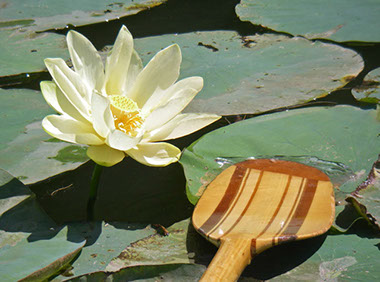
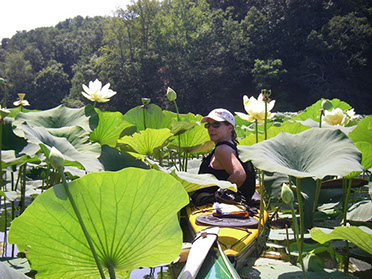
American Lotus, Nelumbo lutea, the largest flower native to North America and one of the largest in the world. Flowers bigger than your head! Definitely not a water lily, it's the closest living relative of the sycamore tree. Blooms July through fall.
Click here to learn more about this amazing plant and where to see it.

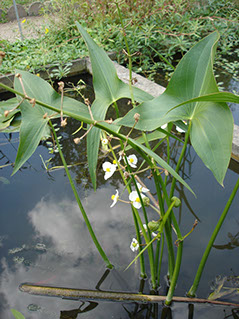
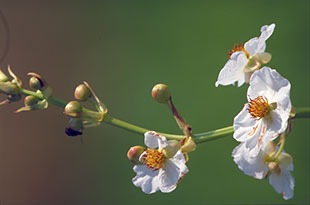
Arrowhead, Duck Potato, Saggittaria latifolia, a aquatic native perennial found in ponds and marshes across North America. The potato-like tubers are eaten by ducks and humans: they were harvested for food both by American Indians and European settlers. Flowers may reach two feet or more above the water. The leaves are shaped like arrowheads. Blooms August into September.
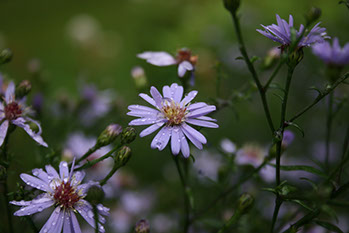

Blue Wood Aster, Symphyotrichum cordifolium, syn. Aster cordifolius, is a perennial native to eastern North America, found along woodland verges and in open areas. The pale blue to purple flowers bloom from mid-August through fall in our area. Flowers have 10 to 15 rays with a yellow to red center and can grow to four foot tall.
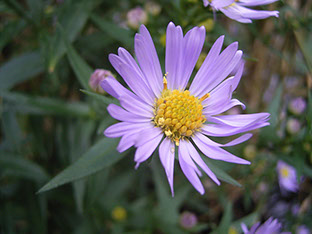
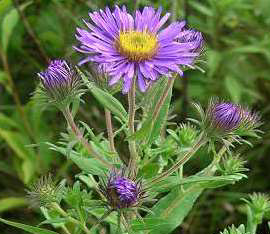
New York Aster, Symphyotrichum novi-belgii, (left) New England Aster, Symphyotrichum novae-angliae, (right) are perennials native to northeastern North America. They are the source of more than a thousand cultivated varities. Bloom August into fall.

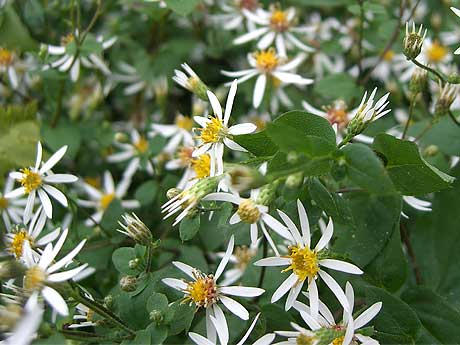
White Aster, Eurybia divaricata, formerly Aster divaricatus, is a perennial native to eastern North America, especially the Appalachians, found in the woods, along woodland verges and in open areas. The white flowers bloom from mid-August through fall in our area. Flowers have 10 to 15 rays with a yellow center and and rarely grows more than two foot high.
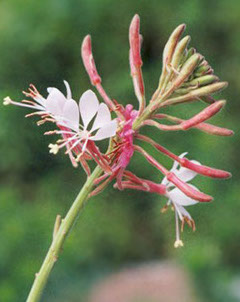
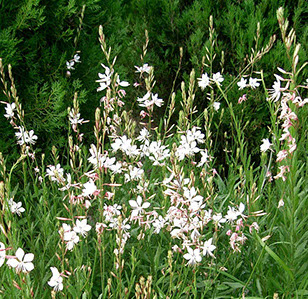

Biennial Beeblossom or Biennial Gaura, Gaura biennis, is a biennial plant related to evening primrose native to the eastern US. The first year it produces no flowers, the second year it takes off and produces clusters of small, pink to white blooms on thin stalks that may reach six ot seven feet high. The flowers are less than a half inch across and have four petals. They open in the morning and may be withered by afternoon. An good food source for butterflies and bees. The spindly stalks swaning in the breeze scatter seeds. Blooms mid-August into September.
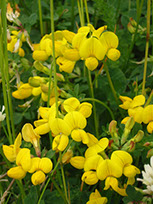
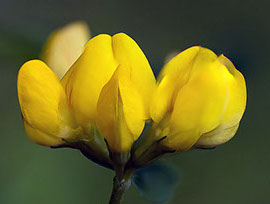
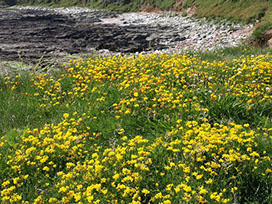
Birdsfoot Trefoil, Lotus corniculatus, Eurasian native widely grown as a forage crop. A pea family member that fixes nitrogen, withstands close grazing and is good for livestock. Blooms all summer.

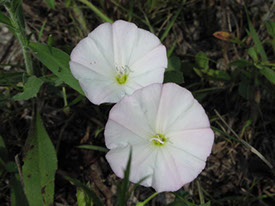
Field Bindweed (above), Convolvulus arvensis. Introduced in the mid 1700s as a crop seed contaminant. Blooms June through fall. This is wild morning glory, so the flowers will close and wither as the day progresses. Flowers that range from pure white to heavily colored or streaked with pink and lavender.
Field Bindweed is distinguished from Hedge Bindweed, Convolvulus sepium, (below) not only by where it choosed to grow, but by the leaves. The plants have three lobed leaves. The base lobes, those closest to the stem, are pointy on the Field Bindweed while those on the Hedge Bindweed are blunt.

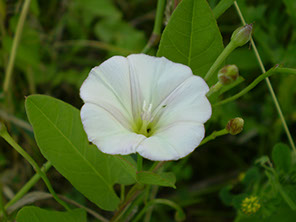
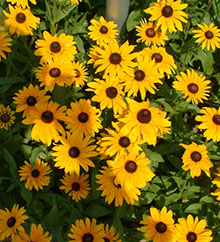

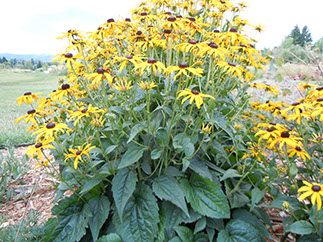
Blackeyed Susan, Rudbeckia hirta, North American native that blooms July into fall. It is an annual that likes moist meadows and woodland verges. Flowers are up to four inches across. The state flower of Maryland.
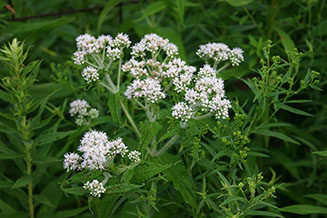
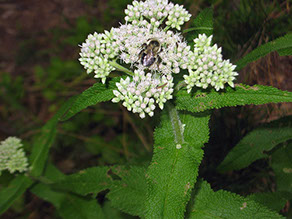
Boneset, Eupatorium perfoliatum, is a perennial native to North America east of the Rockies. It prefers damp soil, and blooms well into the fall. Grows up to three feet tall.
Other members of the large family of Boneset and Throughwort plants include Eupatorium sessilifolium , Upland Boneset (below, left) and Eupatorium resinosum, Pine Barrens Boneset (below right). There are more than 20 species known, and to make matters even more complicated, their native ranges overlap and they easily hybridize.

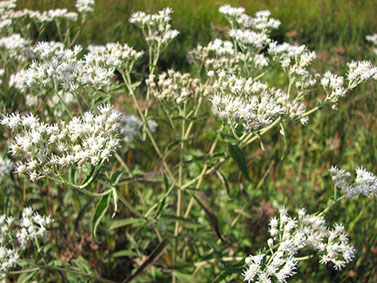
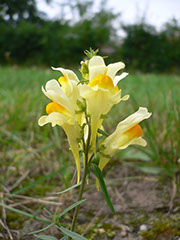

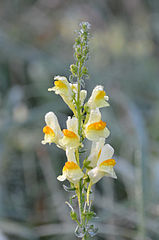
Butter and Eggs, Yellow Toadflax, Linaria vulgars, a Eurasian native and relative of the snapdragon, brought to this country as a garden plant, it has escaped and grows wild across all of North America. This perennial favors well-drained disturbed soils and sunny locations, and produces long-lasting cut flowers. Blooms late July through frost in our area.
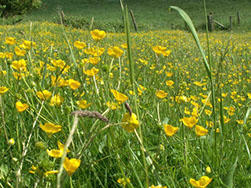

Buttercups, Ranunculus species. Many species of buttercups may be found in our area, some native some not. Most bloom spring through fall.
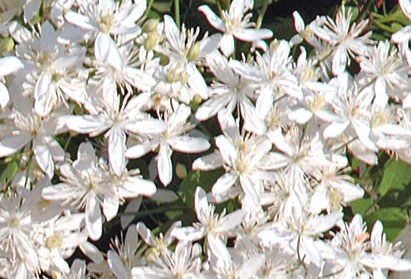
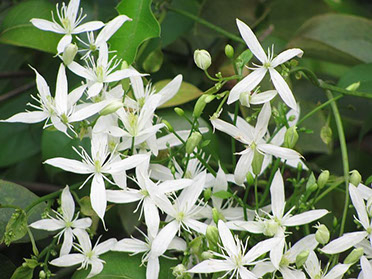
Clematis, Virginia Bower Vine, Clematis virginiana, a perennial climbing vine with fragrent flowers hative to eastern North America. Blooms mid-summer through fall.

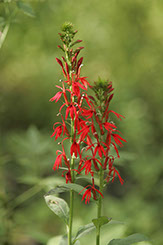

Cardinal Flower, Lobelia cardinalis, is a North American native that grows along stream banks and in marshes. It is common along undeveloped banks on the Delaware, Lehigh and Schuylkill Rivers, and can be found along most natural stream banks in our region that receive some sun. Blooms August into September. Plants may be up to four foot tall.
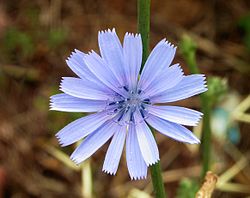
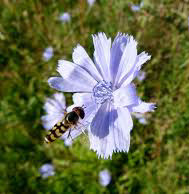

Chicory or Cornflower, Cichorium intybus, a European native naturalized across all of North America. Blooms July through fall. The wild version of the plant cultivated for salad greens, Belgian endive and whose roots are used as a coffee additive or substitute.
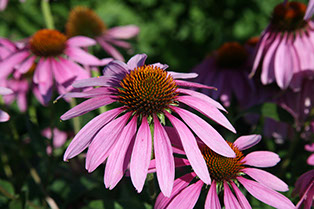
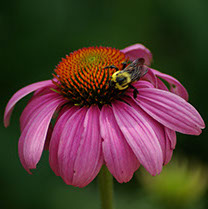
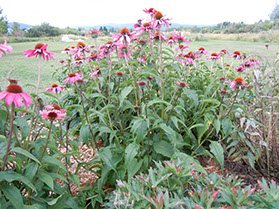
Coneflower or Eastern Purple Coneflower, Echinacea purpurea, an attractive native bloom long used for medicinal purposes by both American Indians and European settlers. Now widely cultivated.
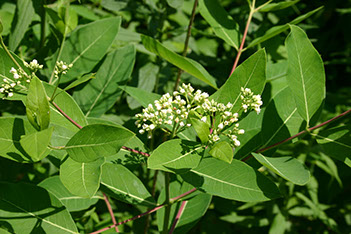
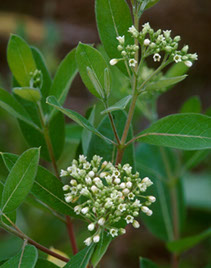
Dogbane, Indian Hemp, Apocynum cannabinum, is a perennial herb native to most of North America. It is highly toxic if eaten, and is a hazard for grazing livestock. It is found in open medows and woodland verges. The cannabinum in its name refers to the similarity to the hemp fiber plant, and it contains no psychoactive drug. Blooms Julne to August. Attracts butterflies.
1.jpg?crc=240919899)
3-crop-u16235.jpg?crc=4284324365)
2.jpg?crc=330717236)
Daisy Fleabane, Erigeron annuus. Also Philadelphia Fleabane, Erigeron philadelphicus, Both look nearly the same, but the latter plant has leaves that closly clasp the stem. Both bloom May well into fall.



Oxeye Daisy, Leucanthemum vulgare, syn. Chrysanthemum leucanthemum. Eurasian native now found in all US states and Canadian provinces. Blooms from late May throughout summer.



Devil's Walking Stick, Hercules' Club or Prickly Ash, Aralia spinosa, a perennial native to eastern US that grows from six to 25 feet tall. Blooms in August in this area and fruits with berries in the fall. Noted for its thorny trunk. See Japanese angelica tree, Aralia elata, at the bottom of the page in the invasive species.
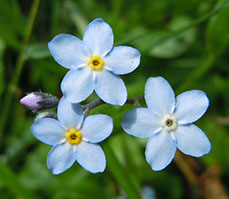

Small Forget-me-not or Bay Forget-me-not, Myosotis laxa, a semi-aquatic native perennial that likes the edges of lakes ponds and streams. The flowers are tiny, less that a quarter inch across. If you can provide any more information on bloom times contact me.
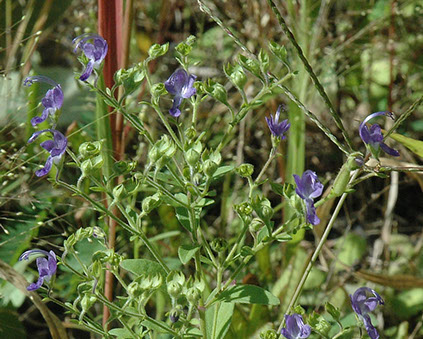
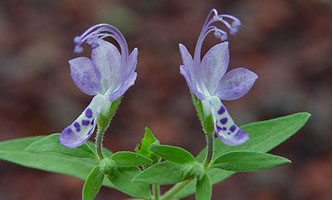
Forked Bluecurls, Trichostema dichotomum, an annual of the mint family native to North America from Ontario to Georgia to Texas to Minnesota. Blooms August into fall.
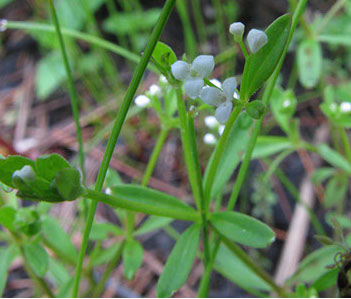
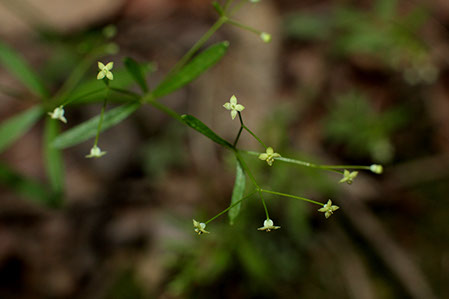
Fragrant Bedstraw, Galium triflorum, a perennial herb native to all of North America and naturalized through much of the world. It produces tiny flowers less than a quarter inch across and blooms in August and September, perhaps thoughout summer, though this has not yet been field verified for this web site.
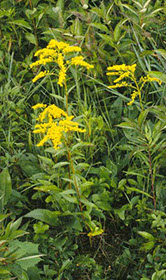


Early Goldenrod, Solidago juncea, a perennial native to eastern North America from the Gulf Coast to Labrador west to the Mississippi. Well named, it is the first of the goldenrods to bloom, starting in late July and early August. A great food for butterflies, it is cultivated to attract them. Grows three to 10 foot tall. See the Goldemrod Page.

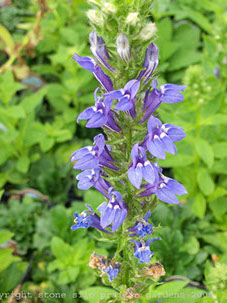
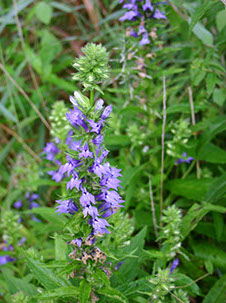
Great Blue Lobelia, Lobelia siphilitica, native to eastern and central North America, is a short-life perennial (lives just a few years) that blooms August well into fall in our area. Grows up to three feet tall and prefers wet to very moist soil.

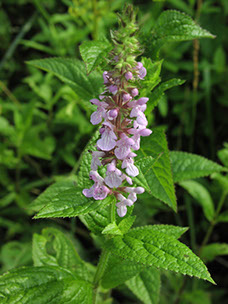
Hedge-Nettle, Stachys tenuifolia, is a member of the mint family, a perennial native to eastern North America that blooms in July and August. One sniff of the plant will clearly indicate its mint family membership. Varities and sub-species are known as the rough hedge nettle, the smooth hedge nettle and the hairy hedge nettle. Variants and synonyms include Stachys glabra, Stachys hispida, Stachys palustris var. hispida, Stachys palustris var. macrocalyx, Stachys tenuifolia var. hispida, Stachys tenuifolia var. perlonga, Stachys tenuifolia var. platyphylla. The plant can grow five foot tall or higher.
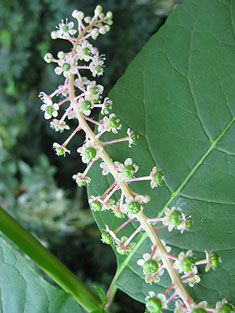
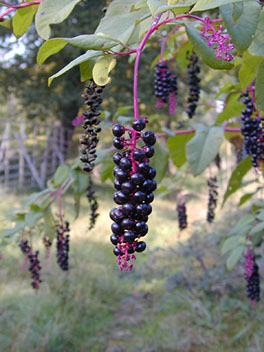

Inkberry or Pokeweed, Phytolacca americana, is a native to eastern North America, a perennial that dies back to the root each year, It has deep red stalks and can grow to 10 foot tall, and produces clusters of small white flowers in late July into August, and fruits into clusters of juicy purple berries from August into September. The plant is toxic, especially the roots, but the young leaves are sometimes eaten as boild greens before the stalks turn red and toxins develop. Research is underway on the potential of the plant as a source of tumor supressing and immune system boosting medications, and extracts are sold on the unregulated suplament market.
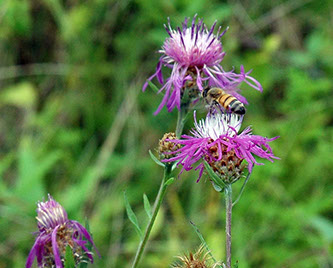

Ironweed: Vernonia gigantia, Vernonia altissima (tall Ironweed, Vernonia noveboracensis, (New York Ironweed) and several other similar and related species are native to eastern North America and prefer moist to damp meadows. They are all related to sunflowers. Altissima can reach 10 foot tall!
,

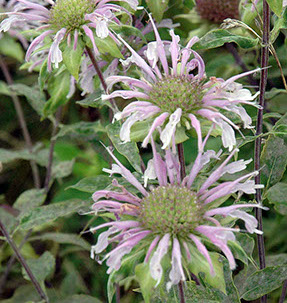
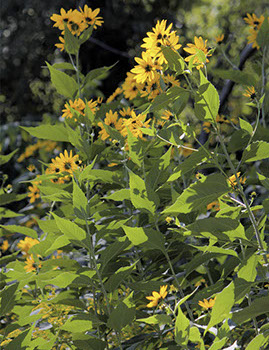
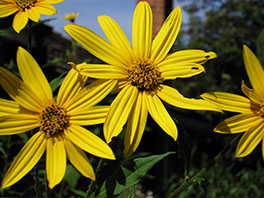
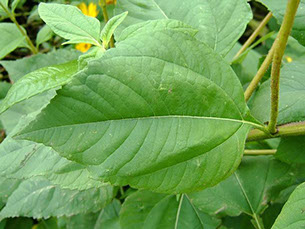
Jerusalem Artichoke, Helianthus tuberosus, a perennial native to eastern and central North America. Long cultivated by Americvan Indians before the arrival of Europeans, this plant is still raised commercially and the esible and tasty tubers sold as suncokes or as Jerusalem artichokes, which a delicious raw or cooked. Grows up to 10 foot high. The flowers are similar to Tickseed Sunflower, Bidens aristosa, but the leaves are broad and the stems are branched and hairy.

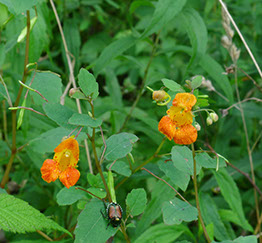
Jewelweed, Spotted Jewelweed, Orange Jewelweed and Touch-me-not are all names for Impatiens capensis, a native North American annual plant with juicy, glassy stems. Dermatological studies have confirmed that crushed jewelweed stems are effective in mitigating contact with poison ivy if applied after contact, followed by rinsing with water. Soap works better, but then few of us carry soap on day trips. Blooms late July into September in our region. May be almost all orange or almost all yellow. The similar Pale Jewelweed, Impatiens pallida, shown below, often grows side by side.

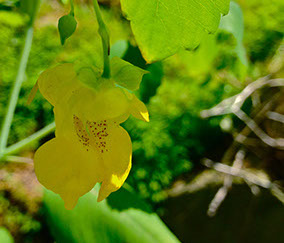
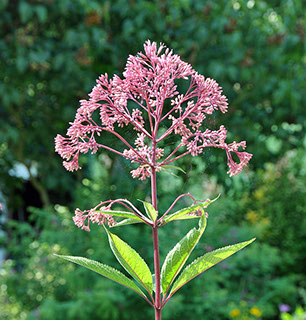
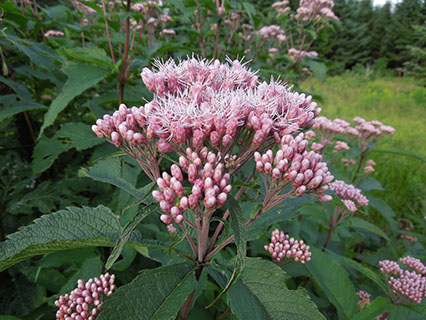
Joe Pye Weed, Eutrochium maculatum, is native to northeastern and north central North America as far south as Kentucky. This perennial grows as tall a five or six feet, and favors moist to wet soil and full sun. Its native habitate is marshes, but it does well in roadside drainage ditches. In our area, blooms late July into fall.

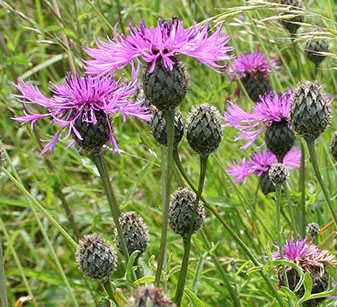
Black Knapweed, Centaurea nigra, a perennial of Eurasian origin that blooms in late summer and fall. The base of the flower is dark. There is also a Brown Knapweed, with a lighter brown flower base.
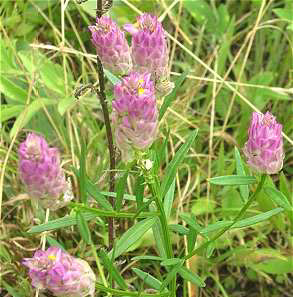
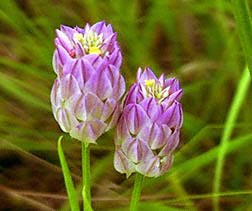
Milkwort, Field Milkwort or Purple Milkwort, Polygala sanguinea, an annual native to most of eastern North America, except for the coastal plain. Likes damp open fields and blooms August through fall.

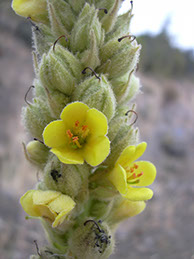

Common Mullein, Verbascum thapsis, a biannual Eurasian native brought to North America as a medicinal plant. The plants grow spikes three to five feet high. Blooms July through September.
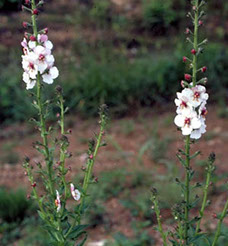

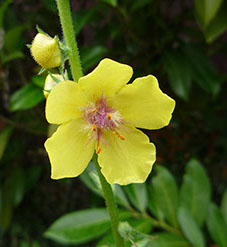
Moth Mullein, Verbascum blattaria, naturalized or invasive native of Eurasia and north Africa. May be white, yellow or shades between.

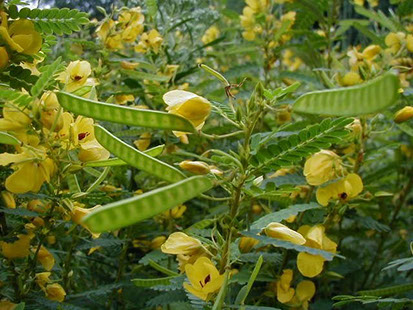
Partridge Pea, Chamaecrista fasciculata, ia an annual plant of nitrogen-fixing legume family native to the US east of the Rockies, except for the Gulf Coast and northern New England. It blooms August to frost in our region, possibly earlier (field verification needed). It produces lots of dime-sized yellow flowers, and in larte summer, pea pods.
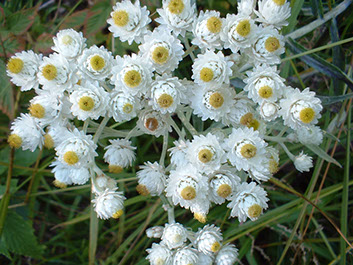
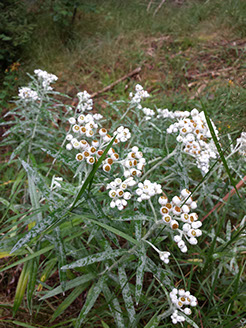
Pearly Everlasting, Anaphalis margaritacea, is native to most of North America, except for the region along the Gulf of Mexico. This perennial favors sunny, well drained locations, and its tiny white blossoms are beloved by butterflies and flower arrangers, who use it as a dried flower. Blooms August into fall.
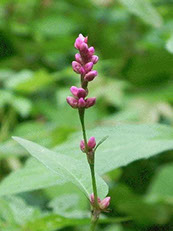
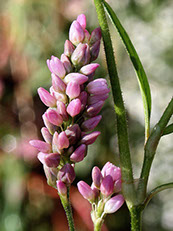
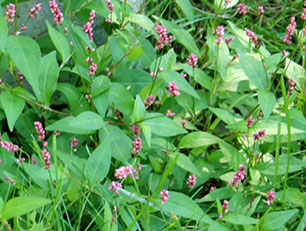
Pennsylvania Smartweed or Knotweed, Polygonum pensylvanicum, a eastern North American native, member of the buckwheat family. Smooth edged eaves about an inch long, pinhead sized buds in elongated clusters, tiny flowers. Major food source for birds. Blooms throughout summer. Also see Virginia Smartweed.

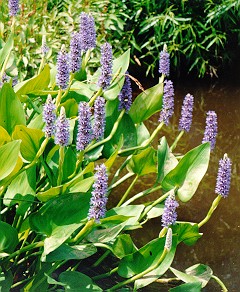
Pickerel Weed, Pontederia cordata, is a perennial emergent aqyatic native to the eastern Americas from Canada to Argentina. It likes full sun and quiet water, and so grows along lake, pond and marsh edges. It grows about four feet high, with the bottom rwo feet underwater. Blooms June through fall in our area.

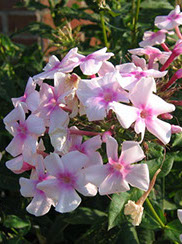
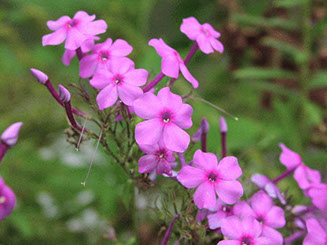
Phlox: Fall Phlox or Garden Phlox, Phlox paniculata, an Appalachian Mountain native perennial now widely cultivated as a garden plant. Blooms August into fall with five-petal flowers ranging from deep pink to nearly white.


Evening Primrose, Oenothera biennis, native to eastern and central North America, a biennial with one to two-inch wide flowers that bloom in the evening and close by noon. Fragrance is somewhat like lemon. Keeps blooming from mid-August hrough fall. Grows two to six feet high.
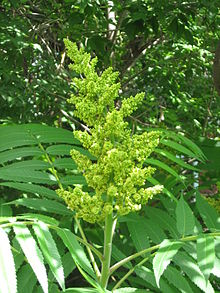
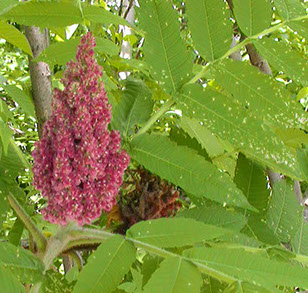
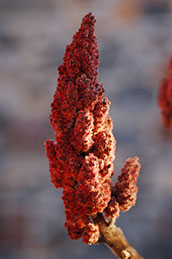
Staghorn Sumac, Rhus typhina, is a flowering and fruiting perennial deciduous shrub that grows as high as 15 foot tall, It native to northeastern United States, adjoining parts of Canada, and south along the Appalachian spine. It flowers largely unoticed in May and June, but by late July and through fall bears conical clusters of deep red fruit that have the appearence of flowers. This fruit can be mashed and soaked in cold (not hot) water for four to eight hours, strained or filtered, and sweetened to make a delicious beverage. Staghorn sumac is not at all related to poison sumac. In the fall the leaves of this plant turn brilliant red, yellow and orange before dropping. Photos show flower, ripe and dried fruit.
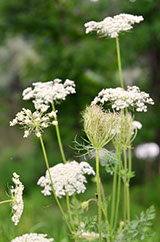

Queen Anne's Lace, Daucus carota, native of Europe, now found worldwide. May or may not have a tiny red flower in the center. The wild ancestor of the carrot. Pull one and look at and smell the root.
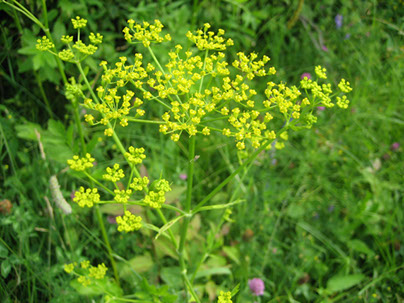
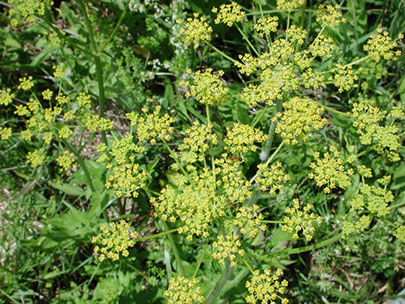
Wild Parsnip, Pastinaca sativa, is related to Queen Anne's Lace and is the ancestor of the domestic parsnip. This biennial native to Eurasia produces an edible taproot in the first year. It flowers in the second year, but by this time the root is woody and inedible, which is also true of domestic parsnips. Be careful handling this plant, as some people get a rash from the sap.

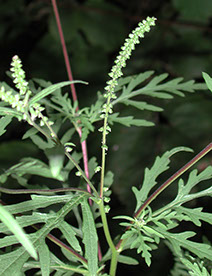
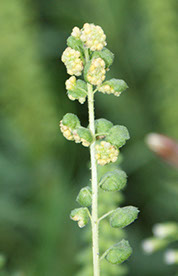
Ragweed, Ambrosia psilostachya, the notorious plant who's pollen is the cause of allergy misery for millions, is a perennial that is native to North America from the southerm provinces of Canada to northern Mexico. Very tiny flowers grow in clusters at the tips of the stems,

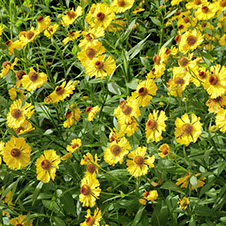
Sneezeweed, Helenium autumnale, is not an allergy-aggravating plant. The name come from its former use: it was dried, powered and used as snuff. It is a perennial native to eastern North America that can grow up to five foot tall, and blooms from August well into fall.
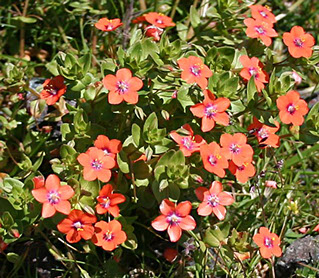

Scarlet Pimpernel, Anagallis arvensis, an annual native of Europe, Western Asia, North Africa and possibly parts of North America, now naturalized worldwide. This low growing plant does well in poor soil. Blooms June through September in our area. The flowers, which are samller than a dime, open only in direct sunlight.

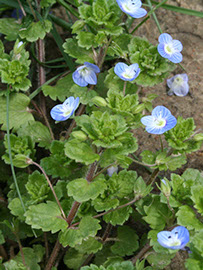
Speedwell, Persian Speedwell, Birdseye Speedwell, Veronica persica, is a seed propagated annual native to Eurasia found throughout North America. Blooms April to August with very tiny flowers less than a quarter inch across.
.jpg?crc=431810116)

Stinging Nettle, Urtica dioica, is a wind-pollinated perennial native to most of the northern hemisphere. In our area, it blooms in late August into fall. Most of us are familiar with this plant as one to avoid, due to the painfull stinging it can produce on the skin. However, the spring greens of the plant ake a delicious cooked green similar in taste to sorrel when cooked. Cooking, which only takes a few seconds, takes away the sting. Wear gloves when picking!
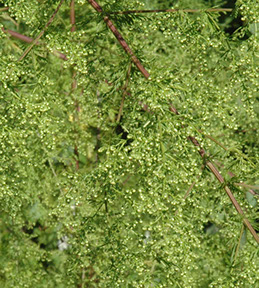


Sweet Annie, Sweet Wormwood, Artemisia annua, an annual native to Asia but now naturalized throughout much of the world. Tiny yellow flowers bloom in late August into September. This very fragrant plant is often picked and used for its scent. Has several uses in both tradatonal and modern medicine, particularly for treating malaria and cancer. Grows six or more feet high.
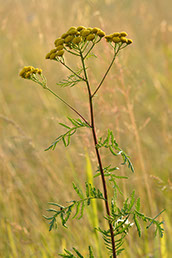
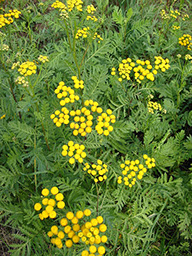
Tansy, Common Tansy, Tanacetum vulgare, a perennial Eurasian native brought here as a medicinal and ornamental plant, now escaped and spread across much of North America. Blooms August into September.
These wildflower pages are a multi-year project. If you wish to be a flower spotter, or otherwise help, contact webkeeper@amcdv.org.
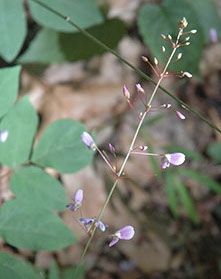
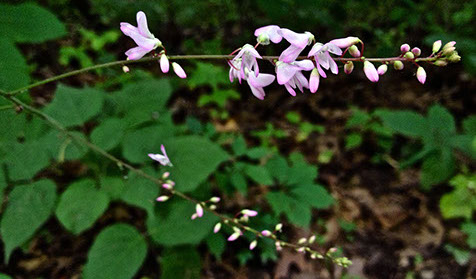
Tick Trefoil, Desmodium glutinosum, Is a perennial native to eastern North America that blooms in August with tiny pink flowers along a stalk that may be two foot long or longer.
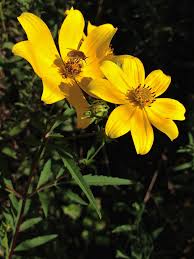


Tickseed Sunflower, Bidens aristosa, a native of eastern and central North America from southern Ontario to the Gulf Coast. A fast-growing annual with lots of two-inch flowers on plants up to five foot tall, it prefers full sun and moist soil. Blooms late July into September. Barbed seeds attach to clothing and hair, and are sometimes called beggers ticks. Flowers are similar to Jerusalem artichoke, Helianthus tuberosus, but leaves are narrow with serrated edges.
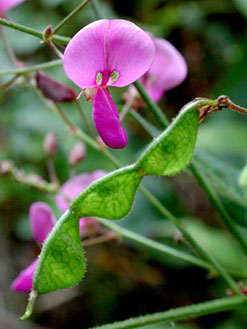

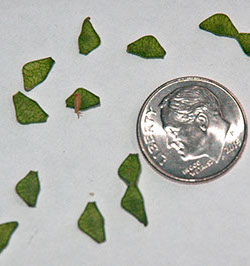
Panicledleaf or Narrowleaf Ticktrefoil, Desmodium paniculatum, a perennial of the pea family native to eastern north America that blooms with tiny flowers in late August or early September. If you have never noticed the plant, you have undoubtly notices the seed podss: tiny triangles that tenaciously adhere to clothing and hair.


Trumpet Creeper, Campsis radicans, a perennial vine native to eastern North America. This aggressive climber attaches to trees, fences walls and can grow to more than 30 feet high. The beautiful waxy flowers almost four inches long attract hummingbirds. Blooms late July into September in our area.
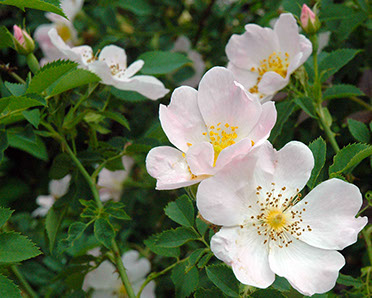
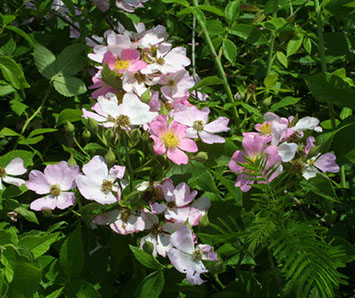
Native wild roses: The Virginia Rose, Rosa virginiana (left) , and the Field Rose, Rosa arvensis. Both are perennials native to eastern North America. The former is a bush or shrub that likes full sun and has many thorns, and may grow to six feet or more tall. The latter prefers woodland verges and field edges and climbs on other plants and fences, and has far fewer thorns. Both have white to pink flowers with five petals about two inches across. Both bloom late May through most of summer, and produce bright red rose hips.
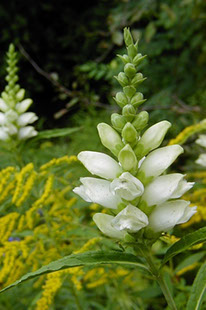
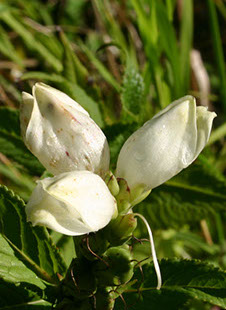
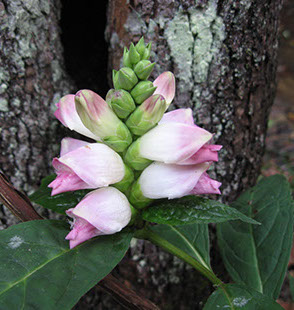
Turtlehead, Chelone glabra, is a perennial native to eastern North America from Canada almost to the Gulf Coast. Grows along river banks and in wetlands, and grows from one to four foot tall before blooming. Flowers from late July into September. A favorite food of deer.

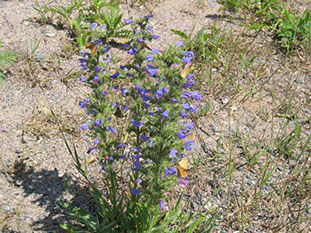
Viper's Bugloss or Blueweed, Echium vulgare, a biannual European native naturalized throughout most of North America. Sometimes grown as an oilseed plant. Grows in open areas and thrives in poor soil.

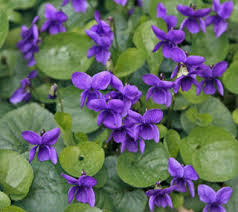
Violets, Viola sororia, synonym Viola papilionacea. State flower of New Jersey. Blooms all summer.


Sweet White Violet, Viola blanda, native to North America, Blooms all summer.
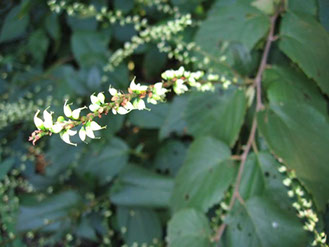
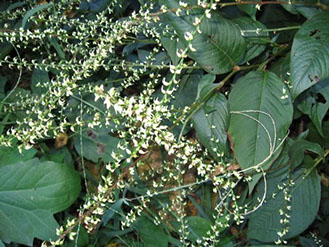
Virginia Smartweed or Virginia Knotweed or Jumpseed, Polygonum virginianum, like Pennsylvania Smartweed, is a member of the buckwheat family. It is a perennial native to the eastern half of North America from Canada to the Gulf Coast. Blooms August into the fall. Does well in full shade.
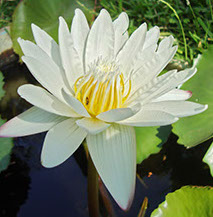

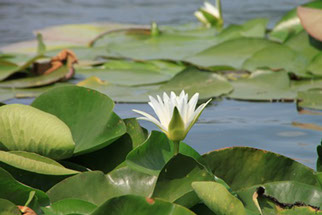
Water Lily, Nymphaea odorata, a native plant found in the shallow parts of lakes and ponds from central America to northern Canada. Blooms July through fall.
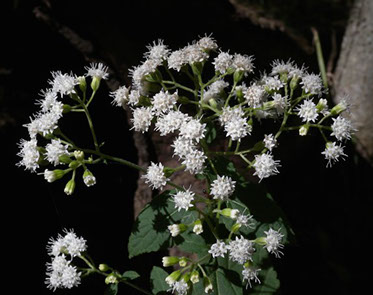
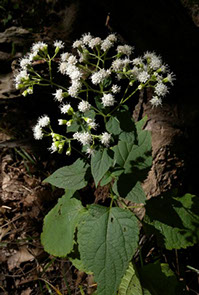
White Snakeroot, Ageratina altissima, syn. Eupatorium rugosum, a shade and moisture loving perennial native of eastern and central North America. Grows 1.5 to 3 foot high. It is toxic to humans and animals, and dairy animals that graze on it can concentrate it and produce milk harmful or even lethal to humans. Blooms through fall.
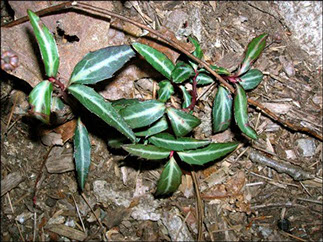

Striped Wintergreen or Spotted Wintergreen, Chimaphila maculata, native to eastern North America south through Central America. Blooms late June through August. You will likely spot the leaves before you see the flowers.
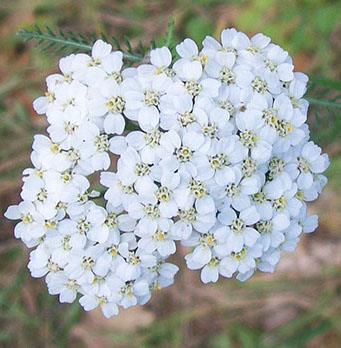
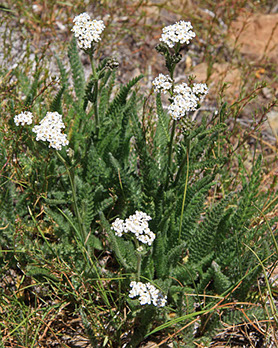
What's in bloom in August Wildflowers in our region that bloom in August. Weeds! Click here

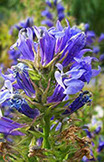
This is a quick guide to some of wildflowers you might see in bloom in our region in August. Do a web search on each plant for larger photos and detailed information. Blooming happens latter in the north and at higher altitude.
If you know of a flowering wild plant that is missing, contact webkeeper@amcdv.org. All photos are in the commons for non-commercial use, as is the information on this page.
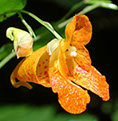

Yarrow, Achillea millefolium, is a perennial native to all parts of the northern hemisphere. In North America, it is a complex of both native and introduced plants and their hybrids. Botanically, it is either treated as ons species with several varities or as several species or sub-species. It grows to three foot tall with a single stem that does not branch except near the top, Blooms June through September.
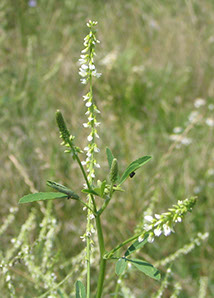
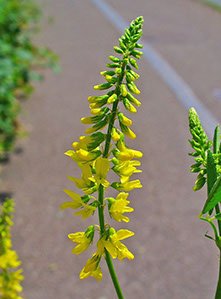
Problem invasive? White Sweet Clover, Melilotus albus, and Yellow Sweet Clover, Melilotus officinalis; also called white or yellow melilot. First imported from Europe as a forage crop in the 1600s, it has spread across almost all of North America and crowds out native species. A biannual that fixes nitrogen, thrives in poor soil and needs lots of sun. Often found along roads and railroads, in vacant lots and disturbed soil.
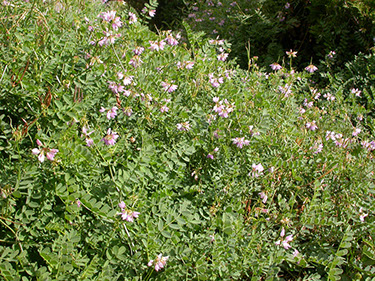
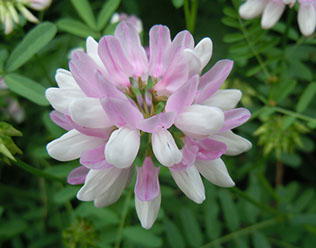
Problem invasive? Crown Vetch, Coronilla varia, is a nitrogen-fixing Eurasian native of the pea family widely used for erosion control since the 1950s. It was once extensively planted along highway cuts and embankments, but it's use has declined since it attracts deer, who like to eat it, and it is sensitive to the herbicides overused by some agencies (e.g., PA Turnpike Commission). Also planted as green manure crop to improve soil. Crowds out native vegetation. Blooms from June throughout summer.

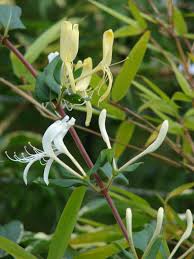
Problem invasive species: Japanese Honeysuckle, or just Honeysuckle, Lonicera japonica. Indigenous to Japan and Korea, it crowds out native vegitation and kills young trees by girdling them. It has a big flush of flowers in June, then continues blooming but with fewer flowers through summer, more so in sunny locations.
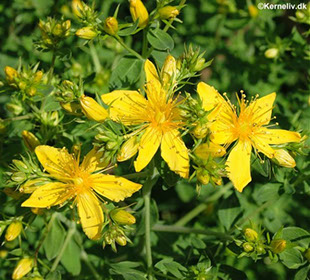
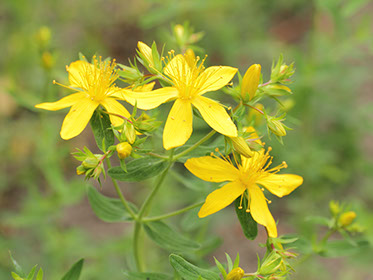
Toxic invasive, St. John's Wort, Hypericum perforatum, is a perennial herb native to Eurasia and North Africa, that is poisonous to grazing livestock. It is now naturalized across North America. Blooms July through August.
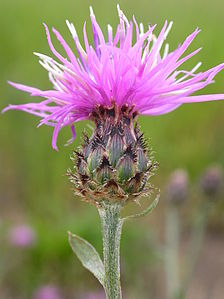
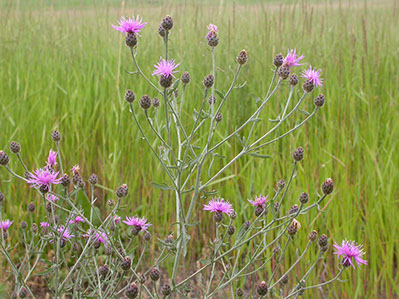
Problem invasive species: Spotted Knappweed, Centaurea maculosa, is a biennial eastern European native that first reached North America the 1800s as a seed contaminant. It out-competes native species by prolific seed production, a deep, water-sucking tap root, and by being inedible to grazing animals. Blooms August through fall in our area.
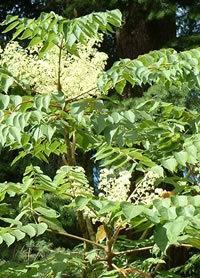
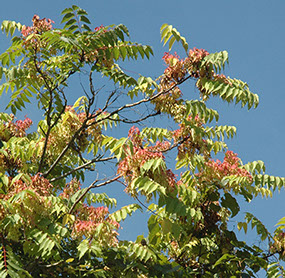
Problem invasive: Japanese Angelica Tree, Aralia elata, a native of east Asia first imported as a garden ornamental, now escaped and listed as a problem invasive by the National Park Service, the US Forest Service and many states in the mid-Atlantic region.Larger than the native Aralia spinosa. White flowers in July give way to orange seed clusters in August.

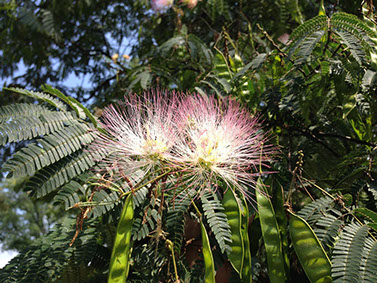
Problem invasive: Mimosa Tree, Albizia julibrissin, Is an Asian import, often planted for its beautiful flowers and foliage. It now grows wild in the US south of Massachusetts. It often bears seeds and flowers at the same time. Breeders are attempting to produce a seedless tree to make it more suitable for ornamental planting. It is fast growing small tree that is often a pioneer species in vacant lots and disturbed soils. Its main problem is that it displaces native species. Fortunately, it is plagued by fungal diseases in the eastern US, which keep it somewhat under control. Blooms summer through early fall.
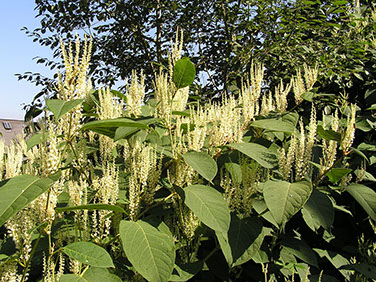

Japanese Knotweed, Polygonum cuspidatum, syn. Fallopia japonica, is one of the worst invasive species in the world, according to the World Conservation Union. Not only does this perennial crowd out native species, its invasive root system and strong growth can block drainage chanels, damage foundations, buildings, roads, paving and retaining walls. It is native to east Asia. Blooms Ausust into fall.

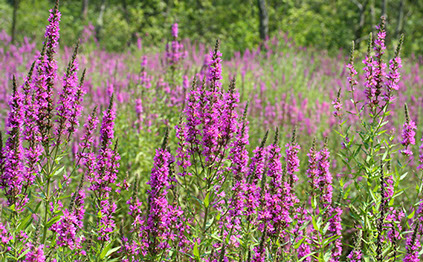
Problem invasive species: Purple Loosestrife, Lythrum salicaria, is a flowering plant native to Europe, Asia and northwest Africa. It arrived here by the early nineteenth century as a seed contaminant, with ship ballast and as a medicinal plant. It displaces native plants that offer much more food and shelter to wildlife. It inhabits wetlands and has spread across North America, often following canals and drainage ditches along roads. Click here to read more about this pest and its control.
